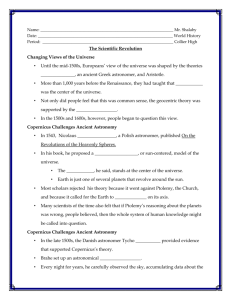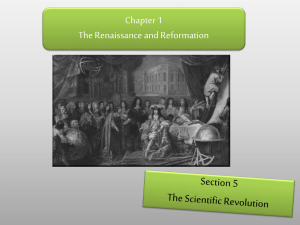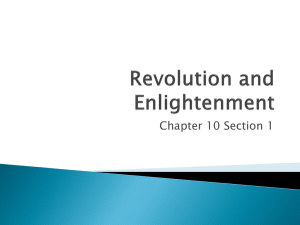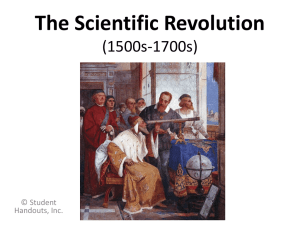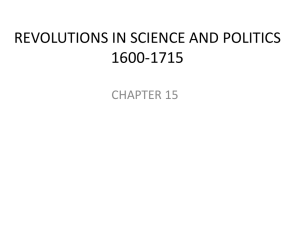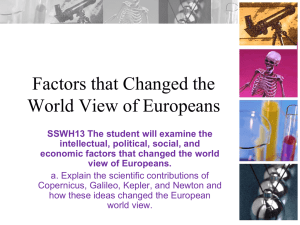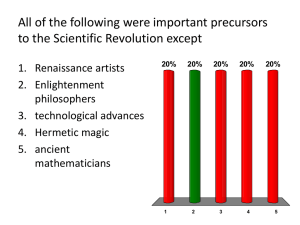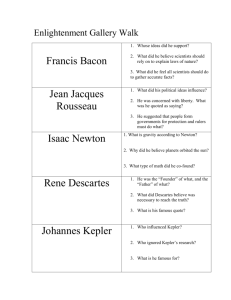The Scientific Revolution
advertisement
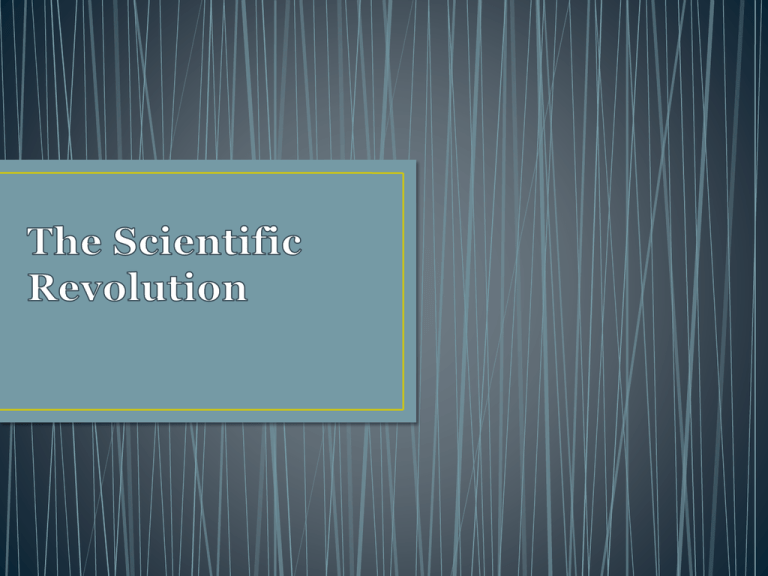
• Explain how new discoveries in astronomy changed the way people viewed the universe. • Understand the new scientific method and how it developed. • Analyze the contributions that Newton and other scientists made to the Scientific Revolution. • Other than military conflict, what was one other impact of the Protestant Reformation on Europe? What other conflicts existed? • Until the mid-1500s, Europeans’ view of the universe was shaped by the theories Ptolemy, an ancient Greek astronomer, and Aristotle. • More than 1,000 years before the Renaissance, they had taught that Earth was the center of the universe. • Not only did people feel that this was common sense, the geocentric theory was supported by the Church. • In the 1500s and 1600s, however, people began to question this view. • Ptolemy’s geocentric model of the solar system: 1. 2. 3. 4. 5. 6. 7. 8. Earth Moon Mercury Venus Sun Mars Jupiter Saturn • Notice, the Earth is first, and not the sun, as it should be. • In 1543, Nicolaus Copernicus, a Polish astronomer, published On the Revolutions of the Heavenly Spheres. • In his book, he proposed a heliocentric, or sun-centered, model of the universe. • The sun, he said, stands at the center of the universe. • Earth is just one of several planets that revolve around the sun. • Most scholars rejected his theory because it went against Ptolemy, the Church, and because it called for the Earth to rotate on its axis. • Many scientists of the time also felt that if Ptolemy’s reasoning about the planets was wrong, people believed, then the whole system of human knowledge might be called into question. • In the late 1500s, the Danish astronomer Tycho Brahe provided evidence that supported Copernicus’s theory. • Brahe set up an astronomical observatory. • Every night for years, he carefully observed the sky, accumulating data about the movement of the Heavenly bodies (stars and planets). • After Brahe’s death, his assistant, the brilliant German astronomer and mathematician Johannes Kepler, used Brahe’s data to calculate the orbits of the planets revolving around the sun. • His calculations supported Copernicus’s heliocentric view. • His calculations also showed that each planet does not move in a perfect circle, as both Ptolemy and Copernicus believed, but in an oval-shaped orbit called an ellipse. • Kepler’s finding help explain the paths followed by manmade satellites today. • Galileo Galilei was an Italian astronomer who built upon the scientific foundations laid by Copernicus and Kepler. • In Italy, Galileo Galilei assembled an astronomical telescope. • He observed that the four moons of Jupiter move slowly around the planet—exactly the way Copernicus said that Earth rotated around the sun. • Galileo’s discoveries caused an uproar. Other scholars attacked him because his observations contradicted ancient views about the world. • The Church condemned him because his ideas challenged the Christian teaching that the Earth was fixed and unmoving. • In 1633, Galileo was tried before the Inquisition, and for a year afterward he was kept under house arrest. • When threatened with death unless he withdrew his “heresies”, Galileo recanted his beliefs and state publicly in court that Earth stands motionless at the center of the universe. • Despite the opposition of the Church, by the early 1600s a new approach to science had emerged, based upon observation and experimentation Known as the Scientific Method. • Scientific Method – method used to confirm findings and to prove or disprove a hypothesis. • Scientists observed nature, made hypotheses, or educated guesses, and then tested these hypotheses through experiments. • Unlike earlier approaches, the scientific method did not rely on the classical thinkers or the Church, but depended upon a step-by-step process of observation and experimentation. 1. 2. 3. 4. 5. 6. 7. State the problem Collect information Form a hypothesis Test the hypothesis Record & analyze data State a conclusion Repeat steps 1 - 6 • Two giants of this revolution were the Englishman Francis Bacon and the Frenchman René Descartes (day KAHRT). • Each devoted himself to understanding how truth is determined. • Both Bacon and Descartes, writing in the early 1600s, rejected Aristotle’s scientific assumptions. • They also challenged the scholarly traditions of the medieval universities that sought to make the physical world fit in with the teachings of the Church. • Both argued that truth is not known at the beginning of inquiry but at the end, after a long process of investigation. • Bacon and Descartes differed in their methods, however. • Bacon stressed experimentation and observation. He wanted science to make life better for people by leading to practical technologies. • Descartes emphasized human reasoning as the best road to understanding. He made his famous statement, “I think, therefore I am.” • The 1500s and 1600s saw dramatic changes in many branches of science, especially medicine and chemistry. The rapid changes in science and technology that began in this period still continue to this day. • Medieval physicians relied on the ancient works of Galen. • Galen, however, had made many errors, in part because he had limited knowledge of human anatomy. • During the Renaissance, physicians made new efforts to study the human body. • In 1543, Andreas Vesalius published On the Structure of the Human Body, the first accurate and detailed study of human anatomy. • Vesalius used whatever means he could to increase his knowledge of anatomy. • He used friendships with people of influence to get invitations to autopsies. • He also autopsied bodies that he himself obtained— counting on friends in the local government to look the other way. • In the early 1540s, French physician Ambroise Paré (pa RAY) developed a new and more effective ointment for preventing infection. • He also developed new surgical techniques, introduced the use of artificial limbs, and invented several scientific instruments. • In the early 1600s, William Harvey, an English scholar, described the circulation of the blood for the first time. • He showed how the heart serves as a pump to force blood through veins and arteries. • Venal valves had already been discovered, but here Harvey shows that venal blood flows only toward the heart. • He ligatured an arm to make obvious the veins and their valves, then pressed blood away from the heart and showed that the vein would remain empty because it was blocked by the valve. • Later in the century, the Dutch inventor Anton van Leeuwenhoek perfected the microscope and became the first human to see cells and microorganisms. • These pioneering scientists opened the way for further discoveries. • The branch of science now called chemistry was in medieval times called alchemy. • Alchemists believed that any substance could be transformed into any other substance, and many of them tried unsuccessfully to turn ordinary metals into gold. • With the advances of the Scientific Revolution, the experiments of alchemists were abandoned. • However, some of their practices—especially the manipulation of metals and acids—set the stage for modern chemistry. • In the 1600s, English chemist Robert Boyle refined the alchemists’ view of chemicals as basic building blocks. • He explained all matter as being composed of tiny particles that behave in knowable ways. • Boyle distinguished between individual elements and chemical compounds. • He also explained the effect of temperature and pressure on gases. • Boyle’s work opened the way to modern chemical analysis of the composition of matter. • By age 24, he had formed a brilliant theory to explain why the planets moved as they did. • In the next 20 years, Newton perfected his theory. Using mathematics, he showed that a single force (gravity) keeps the planets in their orbits around the sun. • According to one story, Newton saw an apple fall from a tree. He wondered whether the force that pulled that apple to Earth might not also control the movements of the planets. • Nature, argued Newton, follows uniform laws. • All motion in the universe can be measured and described mathematically. • To many, Newton’s work seemed to link the sciences just as gravity itself bound the universe together. • For over 200 years, Newton’s laws held fast. • In the early 1900s, startling new theories of the universe called some of Newton’s ideas into question. • Yet Newton’s laws of motion and mechanics continue to have many practical uses. • For example, calculus- a branch of mathematics developed by Newton to help explain his laws—is still used today.
